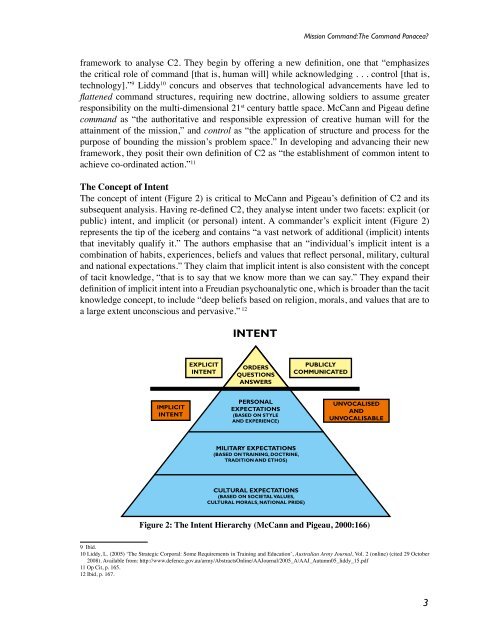Mission Command: The Command Panacea?framework to analyse C2. They begin by offering a new definition, one that “emphasizesthe critical role of command [that is, human will] while acknowledging . . . control [that is,technology].” 9 Liddy 10 concurs and observes that technological advancements have led toflattened command structures, requiring new doctrine, allowing soldiers to assume greaterresponsibility on the multi-dimensional 21 st century battle space. McCann and Pigeau definecommand as “the authoritative and responsible expression of creative human will for theattainment of the mission,” and control as “the application of structure and process for thepurpose of bounding the mission’s problem space.” In developing and advancing their newframework, they posit their own definition of C2 as “the establishment of common intent toachieve co-ordinated action.” 11The Concept of IntentThe concept of intent (Figure 2) is critical to McCann and Pigeau’s definition of C2 and itssubsequent analysis. Having re-defined C2, they analyse intent under two facets: explicit (orpublic) intent, and implicit (or personal) intent. A commander’s explicit intent (Figure 2)represents the tip of the iceberg and contains “a vast network of additional (implicit) intentsthat inevitably qualify it.” The authors emphasise that an “individual’s implicit intent is acombination of habits, experiences, beliefs and values that reflect personal, military, culturaland national expectations.” They claim that implicit intent is also consistent with the conceptof tacit knowledge, “that is to say that we know more than we can say.” They expand theirdefinition of implicit intent into a Freudian psychoanalytic one, which is broader than the tacitknowledge concept, to include “deep beliefs based on religion, morals, and values that are toa large extent unconscious and pervasive.” 12IntentEXPLICITINTENTORDERSQUESTIONSANSWERSPUBLICLYCOMMUNICATEDIMPLICITINTENTPERSONALEXPECTATIONS(BASED ON STYLEAND EXPERIENCE)UNVOCALISEDANDUNVOCALISABLEMILITARY EXPECTATIONS(BASED ON TRAINING, DOCTRINE,TRADITION AND ETHOS)CULTURAL EXPECTATIONS(BASED ON SOCIETAL VALUES,CULTURAL MORALS, NATIONAL PRIDE)Figure 2: The Intent Hierarchy (McCann and Pigeau, 2000:166)9 Ibid.10 Liddy, L. (2005) ‘The Strategic Corporal: Some Requirements in Training and Education’, Australian Army Journal, Vol. 2 (online) (cited 29 October2008). Available from: http://www.defence.gov.au/army/AbstractsOnline/AAJournal/2005_A/AAJ_Autumn05_liddy_15.pdf11 Op Cit, p. 165.12 Ibid, p. 167.3
<strong>Defence</strong> <strong>Forces</strong> <strong>Review</strong> <strong>2010</strong>The Intent HierarchyThe layers’ arrangement and size within their intent hierarchy (Figure. 2) convey their relativeimportance and influence. McCann and Pigeau purposely and effectively make explicit intent“the smallest, most visible aspect of overall intent; built on a whole set of implicit and largelyuncommunicated personal expectations.” 13 They also argue that in an ideal world, all levelsof the hierarchy would co-exist harmoniously with no conflicting expectations, beliefs orvalues. They cite the Canadian Army’s Somalia incident, among others, as a way of reflectingthe stress and confusion induced by “perceived inconsistencies between explicit orders andimplicit cultural beliefs and values.” Here they are pointing to conflicts which arise betweenlayers in the intent hierarchy, and suggest ways of reconciling those conflicts. In doing so theypropose that “beliefs, values and morals that have had more time to instil themselves will bemore enduring and resistant to change.” 14 Mapping their hypothesis onto military operations,they emphasise the need for “overlapping implicit intent . . . in order to . . . maximisesuccess.” 15 By extension they maintain that commanders need to devote considerable timeand effort into establishing shared implicit intent before operations. One way to achieve thisis for commanders to establish a command climate that “fosters trust, confidence, motivation,creativity, initiative, pride, discipline and esprit de corps.” 16They go on to stress that military organisations must continually reinforce and enlarge implicitintent among members at every stage of their careers, maintaining that “sharing implicit intentis at least as much about unconsciously learning subjective norms and developing normativebeliefs as about consciously seeking opinions and achieving consensus.” Two key methodsof achieving this are discussed: exposing soldiers to a consistent set of organisational values,and providing time “to be exposed to one another’s expectations and beliefs.” For a militaryoperation, common intent as a constituent part of C2 is the “sum of shared explicit and implicitintent,” where an organisational structure “that supports the commander . . . and . . . affects thebalance between implicit and explicit intent” is proposed. 17Common Intent, Leadership and Organisational StructureC2, as defined in the preceding paragraph, incorporates both explicit and implicit intentand coalesces within centralised and decentralised organisations. It is argued that in theformer, subordinates will be told what to do and how to do it, whereas in the latter, achievingcommon intent tends to produce high levels of shared implicit intent, leaving the how upto the subordinate. In general, within decentralised organisations, decision-making authoritycharacteristically spreads to subordinates, empowering them with command initiative andindependence.The theory of common intent proposed in Figure 3 is proven to be consistent with a widerange of leadership styles, from autocratic through transactional to transformational, with amixture of all three being present in common intent. At one end of the continuum, autocraticleaders impose their detailed explicit intent, while on the other end transformational leadersindoctrinate followers into their implicit intent hierarchy. According to this hypothesis C213 Ibid.14 Ibid, p. 16815 Ibid, p. 169.16 Ibid, p. 170.17 Ibid, p. 173.4
















